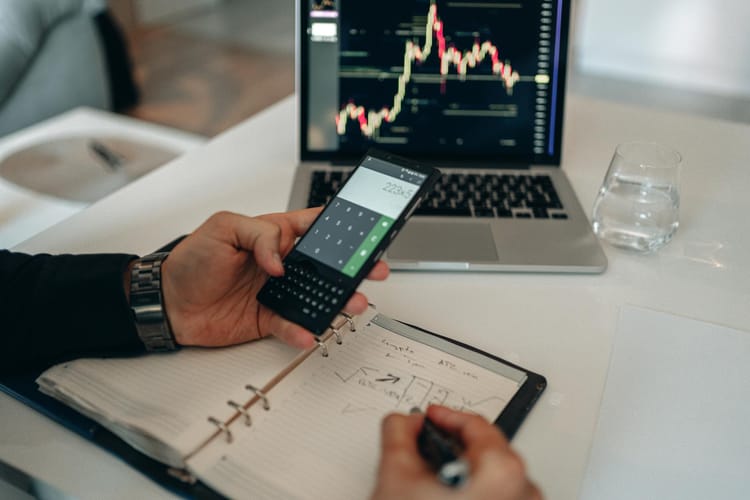What are trade alerts, and how do they affect trading Strategies?

Imagine staring at a screen filled with flashing charts and data streams. Lines go up and down, numbers update by the millisecond, and news headlines scroll across the bottom.
This is the world of a modern stock trader, one where computer screens replace the trading floor. While the environment may differ, the essence remains the same - analyzing information, identifying potential opportunities, and making decisions using the constant data flow.
And here comes the problem,
In this overdose of information, it becomes easy to lose focus, flow in emotions, or miss an opportunity altogether.
This is where trade alerts become a convenient tool.
These automated notifications keep you in the loop when specific market conditions arise.
In the blog post below, we will try to understand the importance of having a robust alert system and how it can inform and potentially improve your trading style.
Let's Start!
What are Trade Alerts?
Trade alerts act as your assistants in this marketplace, constantly monitoring the action and notifying you of specific events that align with your interests. They are automated notifications that trigger when certain conditions are met, helping you stay informed and capitalize on fleeting opportunities.
Here's what the trade alerts offer:
They Provide Real-time updates, eliminating the need for constant manual monitoring, saving you valuable time and allowing you to focus on other aspects of your trading strategy.
This also allows you to customize your alerts to your needs and set parameters based on price movements, technical indicators, news events, or volatility levels.
Alerts can also help you get early warnings notifying you of potential entry or exit points, allowing you to react swiftly to changing market conditions.
All of this helps you to stay disciplined and focused. Trade Alerts constantly remind you of your predefined trading plan and prevent impulsive decisions based on emotions.
This brings us to another critical question to understand,
How many types of Trade Alerts are there?
Before we answer this , a quick fact to develop some basic understanding.
You see, As we have discussed in so many posts before, Trading signals are essentially pointers in the financial market that suggest potential buying or selling opportunities for a particular asset.
But how do you receive these trading signals?
Yes,
Through Trade Alerts, Signals can be based on combination of several alert types,
What types?
Well, there can be many types of alerts, but broadly speaking, we can categorize Trade Alerts into four major categories;
- Price Alerts
- Technical Indicator Alerts
- News-Based Alerts
- Volatility Alerts
Let's have a look into each one with a bit of detail
1. Price Alerts:
A price alert is an automated notification system traders use to receive updates when an asset's price reaches a specific level, either going up or down. You can get these alerts based on the following.
- Breakouts: Notify you when the price breaks above resistance or below support, indicating a potential trend continuation.
- Retracements: Alert you when the price reaches key levels like Fibonacci retracements or moving averages, suggesting potential entry or exit points.
- Target Prices: Trigger when the price reaches predefined profit targets to help you lock in gains.
- Stop-loss alerts: Inform you when the price reaches a pre-determined level to exit a losing position and limit potential losses automatically.
2. Technical Indicator Alerts:
These automated notifications are triggered when specific technical indicators reach certain conditions, potentially suggesting buying or selling opportunities for traders. Such Alerts can be;
- Moving Average Crossovers: Signal potential trend changes based on the relationship between short-term and long-term moving averages.
- Relative Strength Index (RSI) Overbought/Oversold: Identify potential reversal points when RSI reaches extreme values.
- MACD Crossovers: Generate buy/sell signals based on the convergence and divergence of the MACD line and its signal line.
- Bollinger Bands: Alert for potential breakouts or retracements when the price reaches the upper or lower bands.
3. News-Based Alerts:
These are automated notifications based on relevant news events and announcements that could impact your interest in the price of assets. They act as information filters, keeping you up-to-date on developments that hold significant weight in your trading decisions. Examples of such alerts can be;
- Company-Specific Announcements: Notify you of important news releases from companies on your watchlist, such as earnings reports, product launches, or mergers and acquisitions.
- Sector-Specific News: Keep yourself informed of relevant News affecting specific industries you're interested in.
- Economic Data Releases: Alert you for major economic indicators like GDP, unemployment figures, or interest rate decisions that impact broader market sentiment.
- Breaking News: Trigger for significant news events that can cause sudden market movements.
4. Volatility Alerts:
These are your early warning systems!
Volatility in itself is a blessing for traders
Volatility Alerts notify you when an asset experiences sudden and significant price fluctuations. Depending on your strategy and risk tolerance, these fluctuations can present both risks and opportunities for traders. You may receive these alerts based on
- Percentage Change: Notify you when the price of an asset moves by a certain percentage within a specific timeframe, indicating potential increased volatility.
- Implied Volatility (IV) Spikes: Alert you when the implied volatility of an option contract increases, suggesting the potential for more significant price swings.
- Trading Volume Surges: Inform you of sudden spikes in trading volume, which can signal increased buying or selling pressure and potentially higher volatility.
5. Additional Alert Types:
There can be other kinds of alerts over and above the alerts mentioned above. These can be
- Fundamental Analysis Alerts: Trigger based on changes in key financial ratios, credit ratings, or analyst recommendations for specific companies.
- Order Status Alerts: Notify when your existing orders are filled, partially, or cancelled.
- Margin Alerts: Inform you when your account falls below a certain margin maintenance level, requiring you to deposit additional funds to avoid liquidation.
What Kind of Alerts are used for different Trading Strategies?
Now, this is an interesting question!
The kind of trade alert you should get will significantly depend on what type of trading strategy you are following.
For example, swing traders will be more interested in getting results that emphasize trends and support/resistance levels. In contrast, a day trader will want to get alerts based on short-term volatility and momentum indicators.
Let's see some details regarding each strategy;
Trade Alerts for Swing Traders:
Swing traders aim to hold positions for days to weeks. They are more interested in identifying trends and potential support/resistance levels as these can offer insights into where the price might head in the longer term.
As a result, they will benefit from the
Price alerts like Breakouts Above resistance or below support, indicating potential trend continuation or Retracements, reaching critical levels (Fibonacci retracements, moving averages) to identify possible entry or exit points. Swing Traders can also set price alerts based on Target prices, reaching predefined profit targets to lock in gains.
Trader Alerts for Swing Traders can also be based on Technical Indicators like Moving average crossovers signaling potential trend changes based on longer-term price movement. The relative strength index (RSI), which identifies overbought/oversold conditions or volume spikes, Suggests increased buying or selling pressure, potentially indicating a trend shift, and can also serve as a trade alert for swing traders.
Moreover, Swing Traders can also look for alerts based on News and Events like Earnings reports of companies within their watchlist, potentially impacting stock prices or Economic data releases of major economic indicators like GDP or unemployment figures, influencing market sentiment.
Trade Alerts for Day Traders:
Day Traders focus on holding positions for minutes or hours, aiming to capitalize on short-term fluctuations. They are, therefore, more interested in volatility and momentum indicators that can help identify potential short-term buying and selling opportunities.
Therefore, Day traders will be more interested in Price alerts like Intraday support and resistance, Identifying potential entry and exit points based on short-term price movements or Volatility Alerts for sudden price swings, offering opportunities for quick trades.
Day Traders can also thrive on alerts based on News and events like Market-moving news releases, breaking News that can trigger significant price fluctuations or Company announcements Affecting specific stocks within their watchlist.
Other types of Alerts for day traders can be based on Technical Indicators.
These indicators can be based on, for example, Moving average crossovers where Shorter-term moving averages are relevant to day trading strategies or Stochastic oscillators, Identifying overbought/oversold conditions for potential entry or exit points. MACD can also identify possible trend reversals and generate buy/sell signals.
Trade Alerts for Position Traders
Unlike swing traders, Position traders hold positions for longer (months to years). Therefore, their focus shifts from short-term technical indicators to fundamental analysis and macroeconomic trends.
Trade alerts for position traders would focus on News and events impacting the underlying Company's health, industry trends, and broader economic factors like interest rates and economic growth.
Therefore, price-based alerts for Position traders will be based on Long-term trends for confirmation of established trends or potential trend reversals. They can also be found on the valuation metrics, such as reaching specific price-to-earnings (P/E) ratios or other valuation benchmarks.
Similarly, Fundamental Analysis-based alerts can also benefit the position traders. Alerts based on Industry reports Updates on the overall health and outlook of relevant sectors or Company news, and Major announcements like mergers, acquisitions, or significant product launches can help the position traders.
Factors to consider when using Trade Alerts
As with any technological tool, Trade Alerts should also be used cautiously.
There are certain things to be wary of.
First Of all,
Always Avoid Information Overload
Set up only the necessary alerts. Too many notifications can be overwhelming and distract you from focusing on your analysis and trading plan.
The Next thing to consider is to
Prioritize alerts based on your strategy. What this means is to focus on alerts that directly support your trading style and the assets you are interested in
& Always
Utilize filtering options
Many platforms allow filtering alerts based on keywords, sectors, or specific criteria to minimize irrelevant notifications.
Risk Management should be critical when using trade alerts
So, always go for
Signal Validation and Backtesting.
Don't rely solely on alerts. Trade alerts should be used as starting points for further analysis, not definitive buy/sell signals.
Combine alerts with other techniques. Conduct your own research, analyze technical indicators and market context, and understand the reasons behind an alert before deciding.
Backtest your strategy. Test your approach using historical data to assess its effectiveness before deploying it live. This Backtesting helps you refine your strategy and understand how alerts function in different market scenarios.
Remember, alerts should complement your analysis, not replace it.
Conclusion
In conclusion, trade alerts act as your assistants in trading. Notifying you of specific market events and conditions can significantly impact your trading strategies, streamline your workflow, improve efficiency, and potentially enhance your risk management.
Remember, however, that they are merely tools and should be used with thorough research, sound analysis, and a deep understanding of the market dynamics. Utilize them strategically to refine your trading approach, adapt to market fluctuations, and ultimately, strive to make informed decisions for a potentially more successful trading journey.
Trade Smarter!





